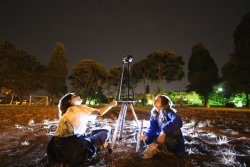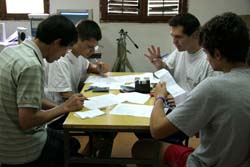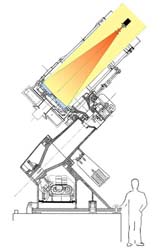Projects
During VSA 2007, work will be divided on four different projects. The topics covered are:
- Analysis of light pollution in Istria
- Meteors
- Near Earth Objects
- Visnjan Observatory robotic telescope
Analysis of light pollution in Istria
Team leader: Zeljko Andreic (Faculty of Mining and Oil Engineering, Zagreb, Croatia)
Primary Aims : To asses the light pollution in Istria peninsula.
Secondary Aims: experiments and modelling of light pollution in small areas (1-2 km).
Requirements: Basic physics and some experience with programming.
Orientation: Field work, data gathering and analysis.
Infrastructure: One, occassionaly two vehicles for accessing remote areas.
Description: Using Unihedron sky quality meter (device for measuring night sky brightness) and digital cameras equipped with wide-angle or all-sky lenses the night sky brightnes on few important sites in Istria will be documented. We will also construct the light pollution (LP) map for the Istria peninsula based on population data and the so called Walker model of LP, and prepare a report for the forcoming regional IDA conference.

Measuring sky brightness near
Pula Observatory (VSA 2006)
Last, all sources of artificial illumination in a small isolated area will be catalogued and sky brightness will be measured on at least several dozen points inside the area. Based on this data we will try to construct a physical model of night sky brightness for this area, and we will try to solve it numerically.
Meteors: correlation of visual, radio and ELF measurements
Team leader: Izidor Pelajic (Faculty of Science, Zagreb, Croatia)
Primary Aims: Observations of Perseid meteor shower using multiple methods and result comparison.
Secondary Aims: Understanding difference between two video systems currently used for meteor observations.
Requirements: Basic computer skills and interest in meteor astronomy.
Orientation: Astronomical - different observation techniques and data reduction.
Infrastructure: Various detectors: video camera, radio antenna, and electrometer. And of course, clear weather :).

Meteor group during data reduction
of visual observations (VSA 2006)
Description: This year new moon gives excellent conditions for visual and video observation of Perseids maximum that we are going to exploit. Using new equipment at Tican meteor station, parallel radio, video and ELF methods will be used for meteor detection. Students interested in ionosphere physics, radio set-up and imaging systems are most welcome. Besides basic computer skills, no other requirements are needed.
Near Earth Objects
Team leaders: Stefan Cikota (Vth Gymnasium, Zagreb, Croatia), Reiner Stoss (Astronomisches Rechen-Institut, Heidelberg, Germany)
Primary Aims: Follow-up newly discovered NEOs and report the data to the MPC.
Secondary Aims: Search for new Small Solar System Objects (Asteroids and Comets).
Requirements: Basic astronomical skills and interest in asteroid and/or comets.
Orientation: Astronomical - work with Remosoft, Astrometrica, MPC web services.
Infrastructure: The observational part is done remotely and on demand in Spain. Remote telescope on Mallorca. Other telescopes at La Sagra (Andalusia). Permanently clear weather favoured, and almost 100% guarantee due to two different sites. In Visnjan only PCs are needed and Internet connection.
Description: In a first step to protect our planet from future impacts of asteroids and comets that could wipe out life as we know it, similar to the dinosaur killer 65 million years ago, the International Spaceguard Survey was started with the goal of finding and categorizing most of the Near Earth Objects (NEOs). Meanwhile several new objects get discovered each day and they get posted immediately on the Minor Planet Center's (MPC) NEO Confirmation Page (NEOCP). Dozens of observatories all around the globe check this page and try to confirm and track these NEO candidates until an orbit can be determined and the objects gets published.

This group will learn to remotely control a telescope over the Internet. It will learn to use the astrometry software Astrometrica and MPC Web Services. The telescope to be used is located at the Observatorio Astronomico de Mallorca on the Spanish Island of Mallorca. In case of bad weather at Mallorca (very unlikely) or in case of hardware problems, we will get images from a similar telescope that is located at the Observatorio de La Sagra, in the Andalusian mountains in Southern Spain. Additionally to confirming recently discovered NEO condidates, we will try to discover new asteroids by searching the sky on our own. Interested students should have an interest in asteroids and comets.
Visnjan Observatory robotic telescope
Team leaders: Aleksandar Cikota (Vth Gymnasium, Zagreb, Croatia), Reiner Stoss (Astronomisches Rechen-Institut, Heidelberg, Germany)
Primary Aims: Improve the local control software to make the 8" VORT controllable over the web.
Secondary Aims: Set up the VORT at Visnjan or Tican for permanent use.
Requirements: Basic astronomical and programming skills.
Orientation: Technical - script and GUI programming, web application.
Infrastructure: Clear weather needed just sporadically. 8" VORT telescope + CCD + Control PC. Access to webserver (direct or via admin). Optional: Material for final installation of VORT.
Description: The Visnjan Observatory Robotic Telescope is a prototype system used to develop software which is necessary to control a telescope over the Internet. Beside being a testing environment for new technology, once operational it is intended to serve students from abroad, enabling them to collect data for scientific projects. This way, students from all over the country can connect via Internet to VORT and collect data for their scientic projects, e.g. for the National Science Fair or VIP Eureka. With its 20-cm of light gathering power the telescope is sensitive enough to track asteroids and comets and measure their position in the sky for orbit determination work.

Schematics of the 1m telescope
Dagor (Tican Observatory)
It can also be used to measure the light variations of asteroids and thus determine the 3D shape of the objects. Variable star monitoring will also be possible with it and many other observations of celestial objects, from the Moon in our neighbourhood out to far away galaxies and even Gamma Ray Burst afterglows. In a first stage, the software must be able to control the telescope locally, from a directly connected PC. This stage is meanwhile reached. The goal of this year's VORT group is to make the control software be reachable over the Internet from a client PC. If this is achieved, a permanent location for VORT shall be elaborated, either at Visnjan or at Tican. Interested students should have basic skills in at least one programming language and have interest in telescopes and CCD cameras.